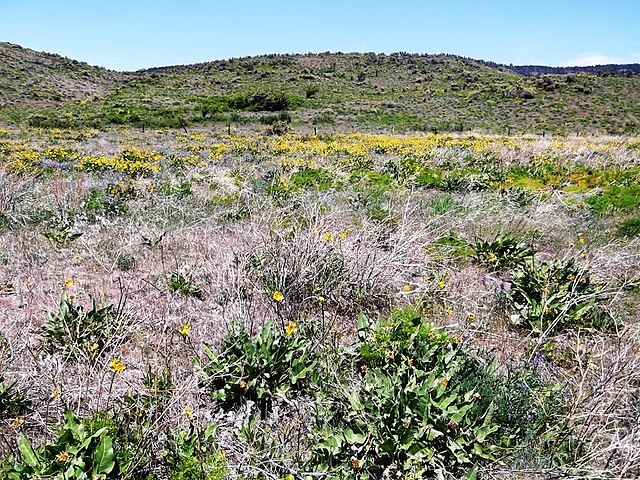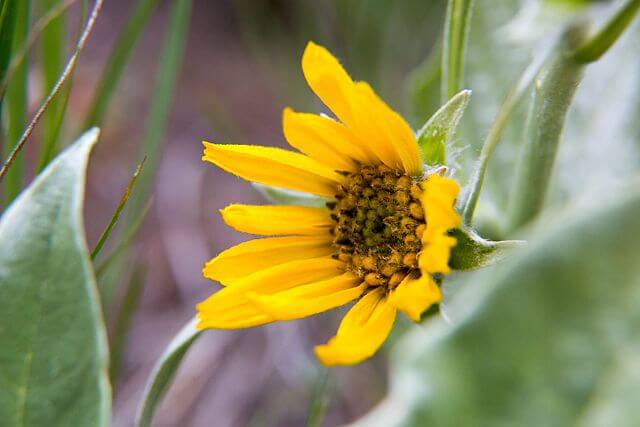Intro to Arrowleaf Balsamroot
Balsamorhiza sagittata, also known as arrowleaf balsamroot, is a flowering plant that is a member of the Aster (Asteraceae) family. This yellow flower is also known as Breadroot, Spring Sunflower, and Oregon Sunflower. Arrowleaf balsamroot is a perennial plant that is native to various areas on the west coast of North America, specifically in the Intermountain West and Rocky Mountains region. Arrowleaf balsamroot grows best in well-drained soil with full exposure to sunlight, so you will most likely find large patches of this flower on hillsides and in prairies that are in mid-range elevations. Other areas to search for this flower include the east of the Dakotas, south of Arizona and Colorado, and from Alberta to British Columbia.

Be sure to check additional locations, such as the surrounding areas of ponds, streams, and marshes. This plant blooms starting in April and through July, although you might be lucky to find a few blooms still going in September. However, arrowleaf balsamroot is not the easiest plant to forage, as the single taproot can grow deep, weighing as much as 30 pounds. For this reason, it is best to harvest the plant parts in the early spring, before the plant blooms. Identifying features to look for when searching for arrowleaf balsamroot include tiny hair-like follicles that grow on the leaves, arrow-shaped leaves (hence the name), and the root that is often the width of a hand.

Uses of Arrowleaf Balsamroot
Arrowleaf Balsamroot has been used medicinally for several years. Indigenous groups in North America, including the Nez Perce, Kootenai, Cheyenne, and Salish, have utilized arrowleaf balsamroot for various purposes. These are only a few groups that are noted to have utilized arrowleaf balsamroot, as many more have used the plant across the west coast. The entire plant may be harvested and used, including the leaves, seeds, roots, root bark, and sap. The common uses that arrowleaf balsamroot is used for include immune system support and respiratory system support.
In these indigenous cultures, the seeds were valuable as both a food source and an oil resource, as well as be dried and ground up into a flour alternative. The largest leaves were turned into a poultice for burns and other wounds but also used primarily as respiratory treatments. The plant’s tissues contain 30% protein and the roots are used as a substitute for coffee when dried, but can also be baked or steamed as a common food source. Arrowleaf’s protein and low maintenance growth make this plant a perfect option for forage for cattle and wild animals, including sheep and deer.
Arrowleaf Balsamroot has been used for a wide variety of purposes including antifungal, antibacterial, antiseptic, antimicrobial, and an immune stimulant, as a few examples. Because of the immune system support, this plant is also commonly used in combination with elderberries, to increase the immune and respiratory support benefits in times of illness. In most cases, you would want to cook the parts of the plant that you plan to use before consumption, as the main root may be bitter and too tough to eat. It was a popular use of the root to boiling it for tea, as the tea would then be consumed to aid in treating conditions such as rheumatism, whooping cough, and headaches.

Conclusion
When looking for your source of arrowleaf balsamroot, be aware that foragers have reported Mule’s Ear, also known as Wyethia, looking similar to this sunflower cousin plant. Although these plants have similar flowers, they do not share similarities in the foliage, as Mule’s ear does not have the staple tiny hairs on the leaves that arrowleaf balsamroot does. It is important to note not to consume large portions of arrowleaf balsamroot as the plant can be irritating to the digestive system and kidneys. Also, avoid consuming this plant if you or someone you know may be pregnant, as the plant can stimulate childbirth.
—————
Written by Jordyn Lee
Jordyn Lee is a freelance writer with a background in herbalism and a passion for sustainable living. She has a Bachelor's degree in Communication Studies and continues to learn more about health and nature. Connect with her on (LinkedIn) or Freelancer Profile (upwork.com).
Many of our readers find that subscribing to Eat The Planet is the best way to make sure they don't miss any of our valuable information about wild edibles.
See our privacy policy for more information about ads on this site






